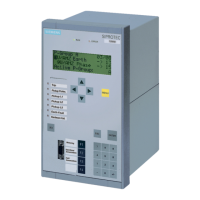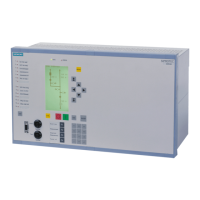The effective duration of the cross-blocking 2203 CROSS BLK TIMER can be set to a value between 0 s
(harmonic restraint active for each phase individually) and a maximum of 180 s (harmonic restraint of a phase
blocks also the other phases for the specified duration).
If the current exceeds the value set in address 2205 I Max, no further restraint will take place for the 2nd
harmonic.
Manual Close Mode (phases ground)
When a circuit breaker is closed onto a faulted line, a high-speed trip by the circuit breaker is usually desired.
For overcurrent or high-set element the delay may be bypassed via a Manual Close pulse, thus resulting in
instantaneous tripping. The internal "Manual close" signal is built from the binary input signal >Manual Close
(no.
356
). The internal "Manual close" signal remains active as long as the binary input signal >Manual Close is
active, but at least for 300 ms (see the following logic diagram). To enable the device to react properly on
occurrence of a fault in the phase element, address 1213 MANUAL CLOSE has to be set accordingly. Corre-
spondingly, address 1313 MANUAL CLOSE is considered for the ground path address. Thus, the user deter-
mines for both elements, the phase and the ground element, what pickup value is active with what delay
when the circuit breaker is closed manually.
[lo_7sj6-hand-ein, 1, en_US]
Figure 2-20 Manual close feature
External Control Command
If the manual close signal is not sent from 7SJ62/64 device, i.e. neither via the built-in operator interface nor
via a serial interface, but directly from a control acknowledgment switch, this signal must be passed to a
7SJ62/64 binary input, and configured accordingly (
>Manual Close
), so that the element selected for
MANUAL CLOSE can become effective. The alternative Inactive means that all elements operate as per
configuration even with manual close and do not get special treatment.
Internal Control Function
If the manual close signal is sent via the internal control function of the device, an internal connection of
information has to be established via CFC (interlocking task level) using the CMD_Information block (see
Figure 2-21).
[handein-260602-kn, 1, en_US]
Figure 2-21 Example for the generation of a manual close signal using the internal control function
NOTE
For an interaction between the automatic reclosing function (79 AR) and the control function, an extended
CFC logic is necessary. See margin heading “Close command: Directly or via Control” in the Setting Notes of
the automatic reclosing function (Section 2.16.6 Setting Notes).
Interaction with the Automatic Reclosing Function (phases)
If reclosing follows, high-speed and simultaneous protection against faults with 50-2 or 50-3 is usually
desired. If the fault still exists after the first reclosing, the 50-1 or the 51 element will be initiated with graded
tripping times, that is, element 50-2 or 50-3 will be blocked. You can use the parameters 1214 50-2 active
or 1216 50-3 active active for this purpose to define whether or not the 50-2 or the 50-3 element is
impacted by a release signal of the internal or an external automatic reclosing system. The setting with 79
Functions
2.2 Overcurrent Protection 50, 51, 50N, 51N
SIPROTEC 4, 7SJ62/64, Manual 79
C53000-G1140-C207-8, Edition 08.2016

